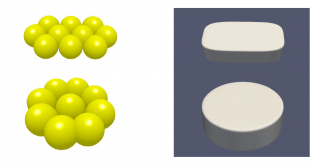During the last 40 years, the discrete element method (DEM) has become an increasingly popular tool for simulating the behaviour of granular materials. To reduce the computational requirements, real particles are represented by idealised geometries. Two of the most popular commercial DEM codes, EDEM [1] and PFC [2], adopt spheres as the basic particles for modelling; non-spherical particles are simulated in these codes by combining multiple spheres into clumps. Other approaches to simulate non-spherical particles include polyhedra, ellipsoids and superquadrics – a generalisation of ellipsoids [3]. Recently, there has been increased emphasis on modelling non-spherical particles with reasonable fidelity to improve the quantitative agreement between DEM simulations and real particle systems.
The overall aim of this research is to improve the efficiency with which large systems of nonspherical particles can be simulated. To achieve this, several aspects of modelling are considered:
- Compare superquadrics and multi-sphere clumps, such as those in Figure 1, in terms of their computational cost and ability to capture the key responses of experimental systems. •
- Develop an improved contact detection and evaluation methodology for polyhedra and superquadrics, i.e., determine whether two non-spherical particles are in contact and, if so, quantify the interparticle overlap used to compute contact force. •
- Determine efficient, stable time-steps for simulations of non-spherical particles. The most common implementation of DEM is based on a conditionally-stable time-stepping algorithm, and highly conservative time-steps are currently used to ensure stability.
Finally, this research will be applied to several engineering applications involving large-scale systems of non-spherical particles.
References
[1]DEM Solutions Ltd, https://www.edemsimulation.com/. EDEM 2018, 2018.
[2]Itasca Consulting Group Inc. PFC 5.0 Documentation, 2015.
[3]G. Lu, J. R. Third, and C. R. Müller. Discrete element models for non-spherical particle systems: from theoretical developments to applications. Chemical Engineering Science, 127:425 – 465, 2015.



